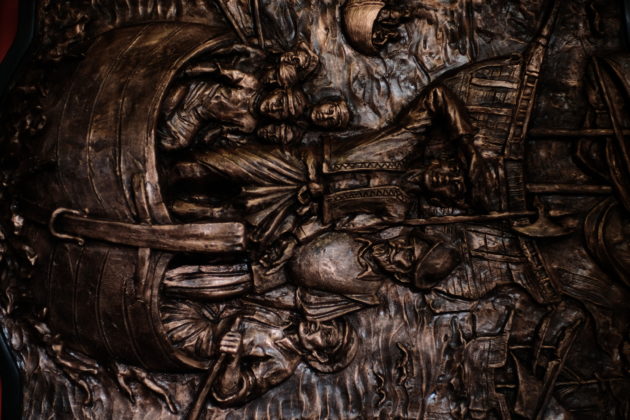Maguindanao, 500 Years Ago
Posted on 23 October 2021
By Rene R. Escalante, Ph.D.
This year, we are commemorating the 500th anniversary of the Philippine part in the first circumnavigation of the world. There are thirty-four milestones associated with it, collectively known as the 2021 Quincentennial Commemorations in the Philippines. A lot of us might think that these are relevant only to the Christian Filipinos because of the 500th anniversary of the introduction of Christianity in the Philippines. Others might misconstrue that this is nothing but a celebration of the coming of Magellan or the Spaniards, which is wrong.

Since 2018, the National Quincentennial Committee has been championing the Filipino viewpoint of revisiting the history of the first circumnavigation of the world, 500 years ago. We are actually using this global platform to correct misconceptions about our ancestors. It is also our opportunity to advance our collective cause, and that is to prove that our ancestors had culture and civilization prior to the arrival of the Spaniards. We have been educated that our ancestors were savages and barbaric. We were taught that Philippine History began when Magellan arrived in 1521. For almost a century since the time of Rizal, these myths have been rectified and continuously being corrected. The very presence of Islamic faith here in Mindanao more than a century prior to the arrival of Magellan to the Philippines was proof of our ancestors’ exposure to greater communities and influences in Asia.
But as the world commemorates the 500th anniversary of the first circumnavigation of the planet, we need to assert our place in this epic journey that proved that the Earth was indeed round. In October 1521, our ancestors in the Sultanate of Maguindanao were prominently mentioned in the accounts of Antonio Pigafetta, the chronicler of the Magellan-Elcano expedition. He described Maguindanao as a “Citta grande” or a large city, regard he never ascribed even to Cebu nor Brunei. The expedition was looking forward to land in Maguindanao to replenish their depleting provisions, conduct trade, and look for a possible pilot who would assist them to reach their ultimate destination—the famed Maluku, down south of Mindanao in today’s Indonesia. Although they knew that the area was dominated by the Muslims, the expedition behaved accordingly, following the Battle of Mactan of 27 April 1521 which killed their pioneer captain-general, Ferdinand Magellan.

Unfortunately, the expedition did not land in Maguindanao because while in the sea, they had encountered a large boat of the sultanate called binigday. Aboard the colossal sea vessel were relatives of the Maguindanao Sultan, one of whom was his brother. Reportedly, one of the datus in the binigday was held captive by the remaining crew of Magellan’s expedition. But before we raise our eyebrows at these foreigners, one must reread the backstory of why they had to capture the said Maguindanao chief. The dreaded, almost hopeless, and deplorable expedition was desperate to reach the Maluku. Upon knowing that the said Maguindanao chief knew personally the Portuguese officer of the Maluku, Francisco Serrao, the expedition became hopeful. Serrao, by the way, was a relative of Magellan. He was actually the one who convinced Magellan to go to the Maluku. They brought him aboard and took part in the expedition as a pilot. Halfway to the Maluku, the datu escaped.
Most of us do not know that the Sultanate of Maguindanao had a significant role in the success of the first circumnavigation of the world. Through this historical marker we unveiled here at Cotabato City, the ancient seat of the Sultanate of Maguindanao, we are reclaiming the honor on behalf of the unnamed datu of the Sultan of Maguindanao who served as pilot of the Magellan-Elcano expedition.
Aside from these historical facts, we can learn from this episode of the first circumnavigation of the world how connected Maguindanao was to the rest of Southeast Asia, more so to Serrao who was actually the man who inspired Magellan to go to the Maluku and eventually launched a Spanish expedition. We do not mean to appraise the Spaniards nor Magellan by erecting this landmark but to commemorate the achievement of science and humankind in understanding our home planet even more.
In the last ten years, it has been the goal of the National Historical Commission of the Philippines to increase its projects, initiatives, and cooperation in Mindanao, most especially in the Bangsamoro Region. We are grateful that we have the Bangsamoro Autonomous Region in Muslim Mindanao’s Commission for the Preservation of Cultural Heritage as one of the member-affiliates of the NHCP Local Historical Committees Network. But more than this, we want to present proof of how we integrate the Bangsamoro into our national history. Furthermore, we would like to thank the City Government of Cotabato for being our partner in this humble project of integrating Bangsamoro in national and world history.
About the Author
Rene R. Escalante, Ph.D. is the Chairperson of the National Historical Commission of the Philippines and concurrently the Executive Director, National Quincentennial Committee

